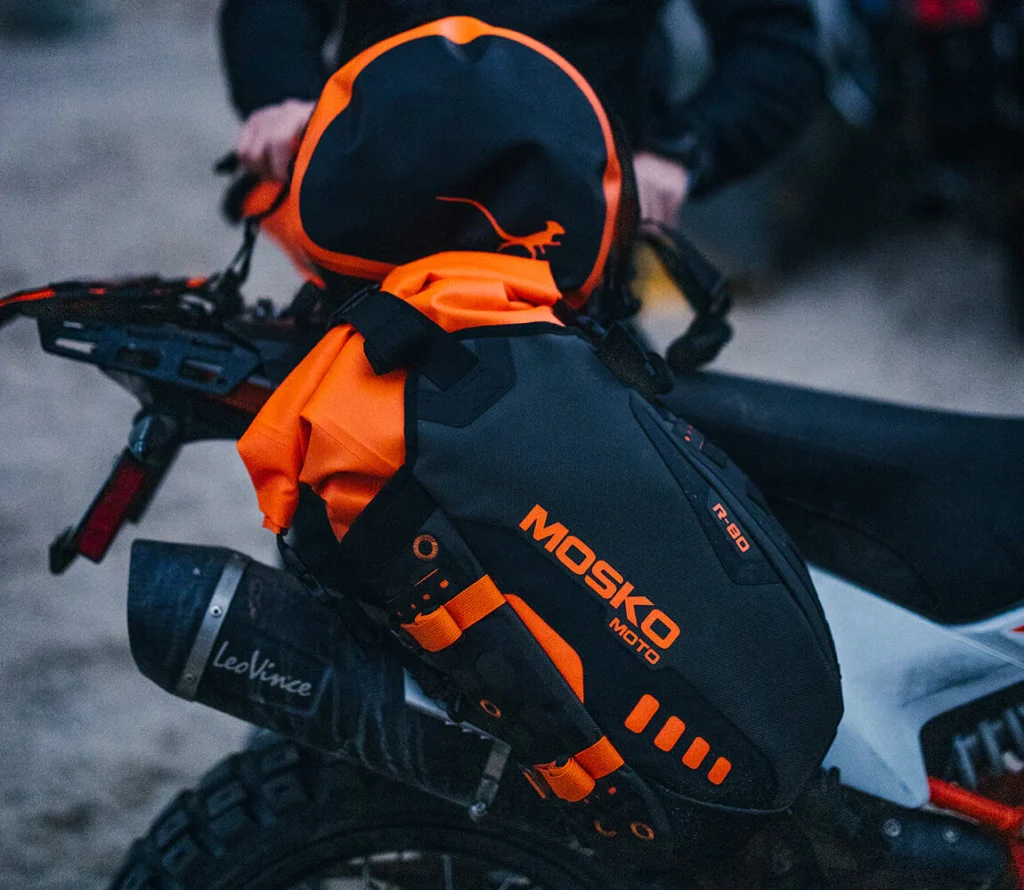In the uncompromising world of adventure motorcycling, luggage systems are not accessories; they are critical equipment. They represent a pact between the rider and the unknown—a promise that everything needed to survive and thrive will arrive intact, regardless of the terrain or conditions. The Mosko Moto Reckless 80L (V4.0) is not merely a set of bags; it is a meticulously engineered system designed to uphold that pact. It eschews the rigid architecture of traditional pannier racks in favor of a robust, flexible, and body-hugging design built for the specific demands of aggressive, off-road travel.
At the heart of the V4.0 system lies its most significant evolution: the harness. Previous iterations, while effective, were subject to the inherent flex of ballistic nylon. Version 4.0 integrates a semi-rigid harness crafted from CURV®, a thermoplastic composite known for its high impact strength, low weight, and resistance to fatigue. This is the same class of material found in high-performance ballistic armor and motorsport components. Its inclusion here is not a trivial upgrade. In practice, the CURV® harness acts as a lightweight chassis for the luggage, drastically reducing lateral movement and sway during technical maneuvers. This translates to a more stable and predictable machine, allowing the rider to focus on the trail, not the load. The system feels less like an appendage and more like an integrated part of the motorcycle’s subframe.

Deconstructing the System: Materials and Architecture
The Reckless 80L is a modular, three-part system: two 25L side holsters and a 22L central tail bag, creating a nominal 72L of primary capacity, with expansion options pushing the total volume past 80L. The design philosophy is one of layered defense.
The outer harness, constructed from 100% recycled 1680D ballistic nylon and reinforced with Hypalon armor panels in high-abrasion zones, serves as the primary load-bearing structure. This is the first line of defense against impacts and abrasion. The choice of 1680D nylon is deliberate—it provides an exceptional balance of toughness and reasonable weight, a critical engineering trade-off.
Within this protective exoskeleton reside the system’s waterproof lungs: three independent, welded-seam drybags made from durable 840D TPU. This dual-bag architecture is fundamental. It isolates the waterproof layer from the rigors of the trail, ensuring that even if the outer holster is compromised by a fall, the inner sanctum remains impervious to water and dust. The side drybags are interchangeable and feature a clear front panel, a small but significant detail that eliminates guesswork when retrieving specific gear.
The central component is the Stinger 22L Tailbag, a versatile drybag that can be removed quickly and includes stowable backpack straps. This transforms it from motorcycle luggage into a functional daypack for off-bike excursions or a convenient carry-on for fly-to-ride trips.

Real-World Application: Beyond the Spec Sheet
On the trail, the system’s stability is its defining characteristic. Once the adjustable leg angles are set for a specific motorcycle and the four main attachment straps are cinched down, the Reckless 80L exhibits minimal unwanted movement. The low-profile cam buckles hold their tension without slipping, and the meticulous strap management system prevents interference with the rider or the machine’s moving parts.
Functionality is enhanced by a host of intelligently designed features. The rear “beavertail” provides a perfect stash point for a wet tent fly, a damp jacket, or a collection of firewood, keeping them isolated from the main drybags. Within the beavertail are dedicated pockets for a tent pole bag and a removable document holder. Multi-directional MOLLE panels on the beavertail and leg holsters offer a standardized platform for expansion, allowing for the attachment of auxiliary pouches, fuel bottles, or first-aid kits.
However, the system is not without its considerations. Its “rackless” designation comes with a caveat. While it eliminates the need for traditional steel side pannier racks, a rear top rack is highly recommended, particularly on smaller dual-sport motorcycles. This provides a more stable and durable platform for the central bag and helps distribute the load off the motorcycle’s plastic tail section and aluminum subframe, mitigating the risk of long-term stress failure.
Furthermore, meticulous installation is not optional; it is mandatory. The stability of the system is directly proportional to the care taken in its setup. Every buckle must be seated, and every strap must be tensioned correctly and secured. For bikes with high-mounted exhausts, particularly singles like the KTM 690 or Husqvarna 701, the included heat shield is not a suggestion but a critical component to prevent catastrophic failure of the luggage.

A Purpose-Built Tool for Serious Travel
The Mosko Moto Reckless 80L (V4.0) is a premium tool that commands a premium price. It is not for the casual weekend camper. This is a system built for the relentless demands of backcountry discovery routes, multi-week expeditions, and international travel where equipment failure is not an option. The introduction of the CURV® composite harness elevates the platform, delivering a level of stability that rivals many rack-mounted systems while retaining the weight and flexibility advantages of soft luggage. It is a robust, intelligently designed, and field-proven solution that prioritizes durability and functional stability above all else. For the serious adventure rider who demands an uncompromised load-carrying system, the Reckless 80L is an investment in mission assurance.

